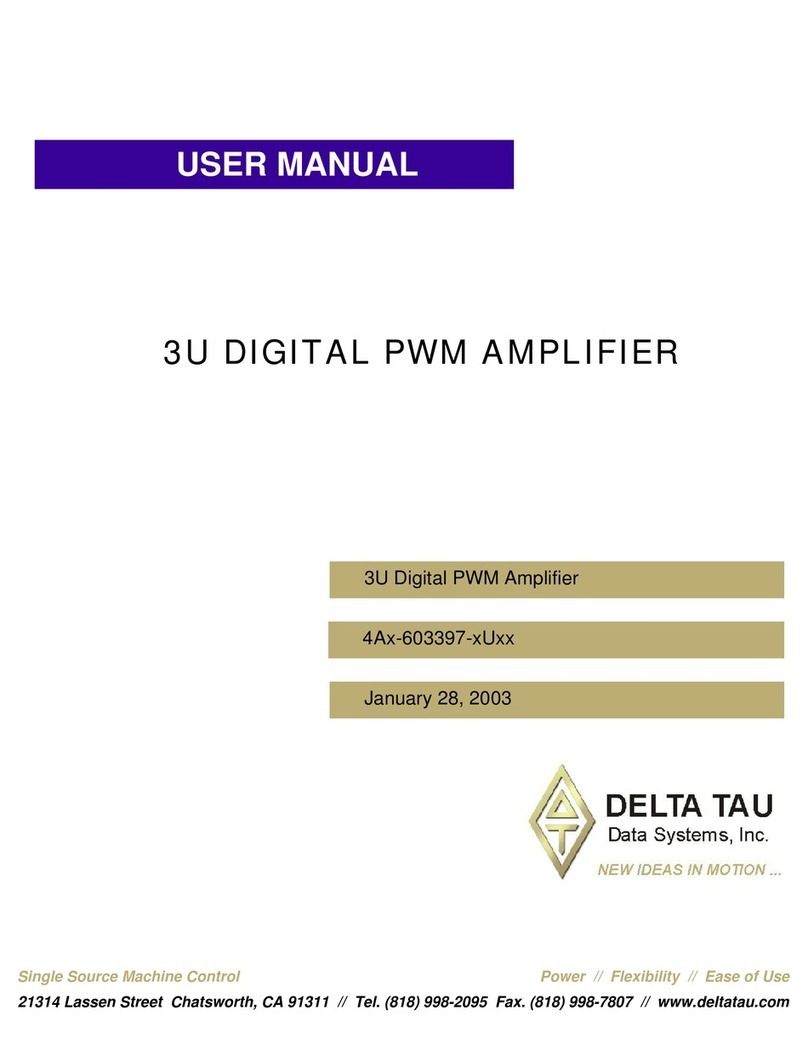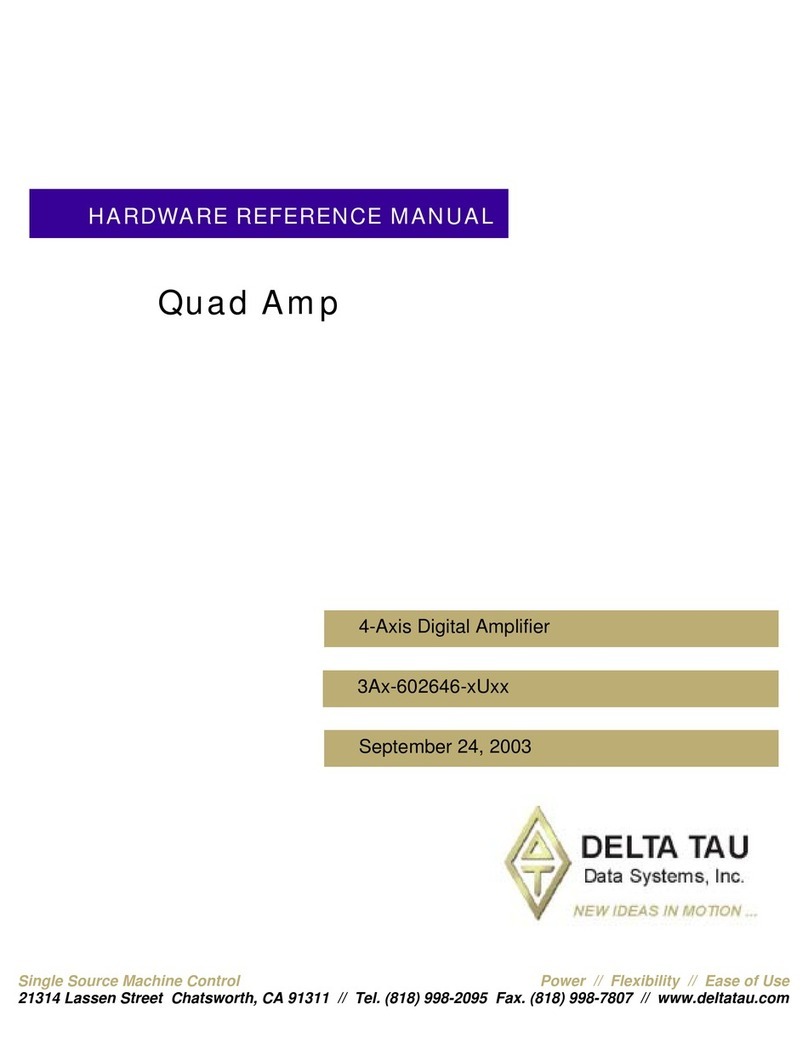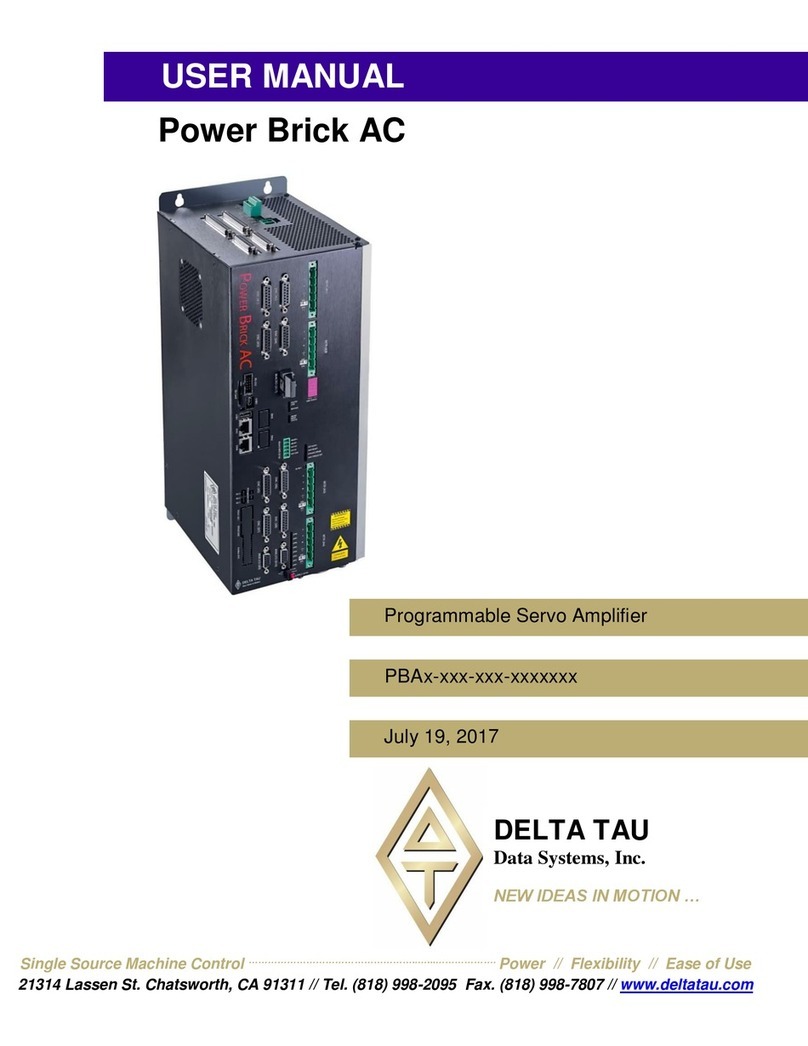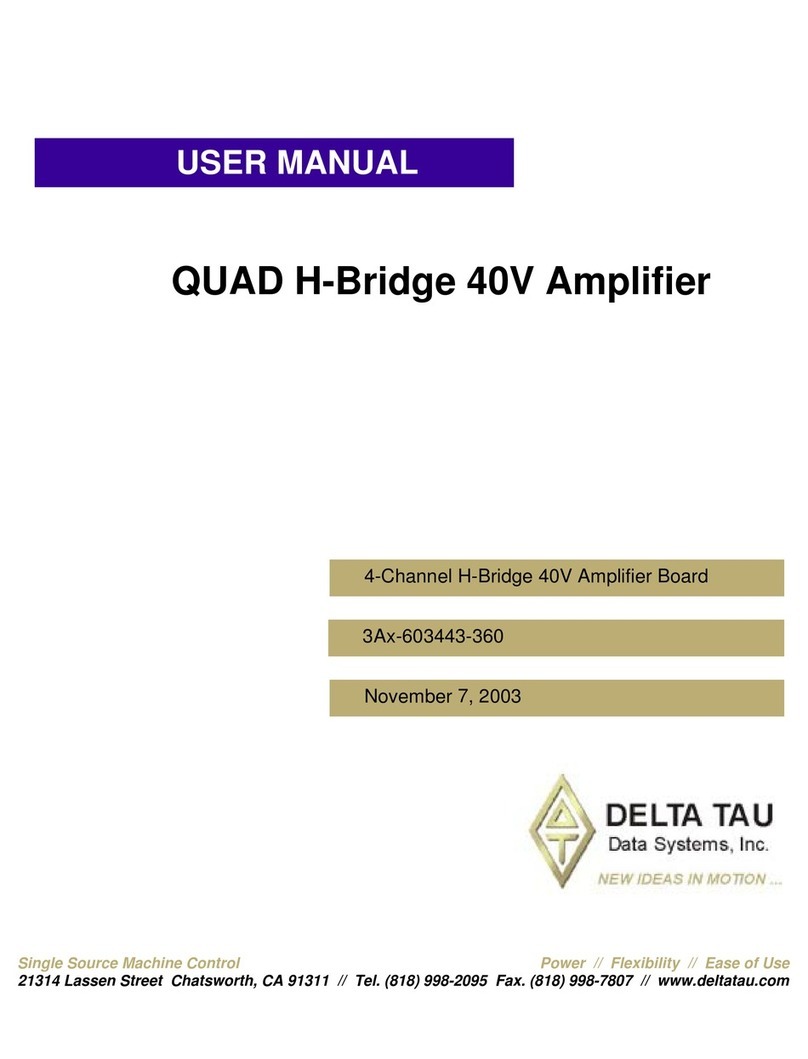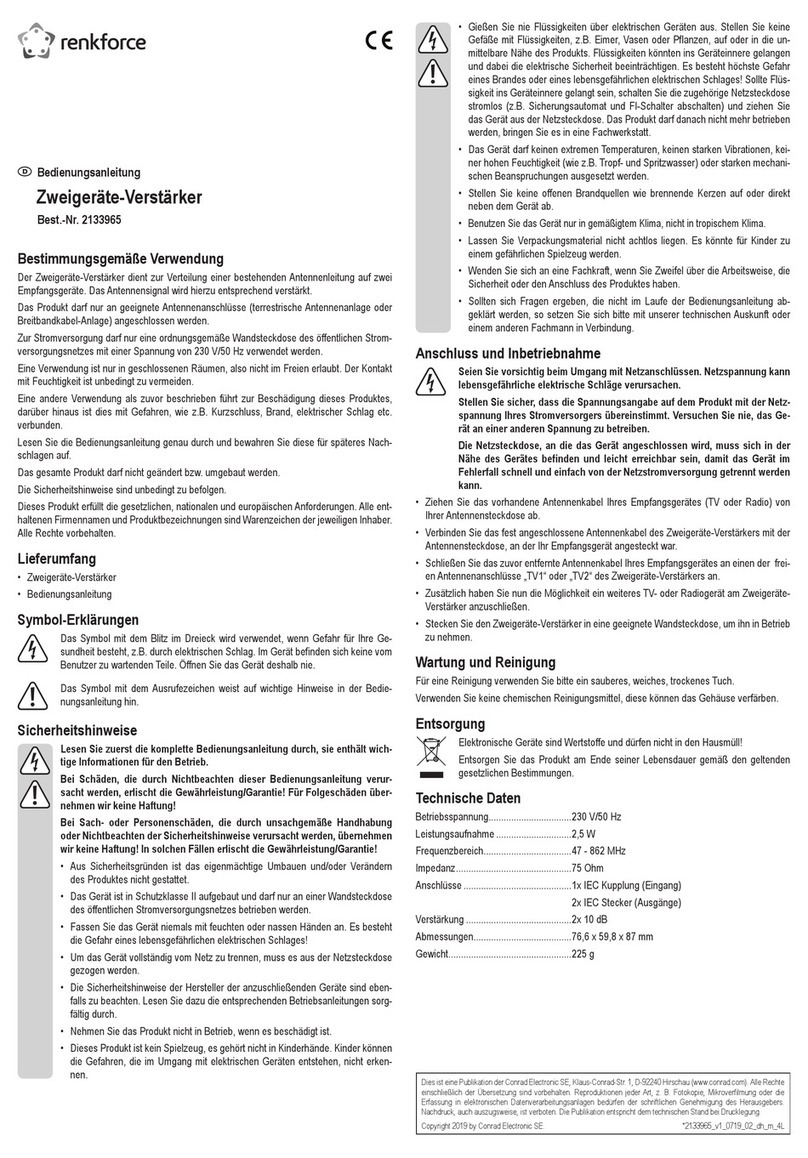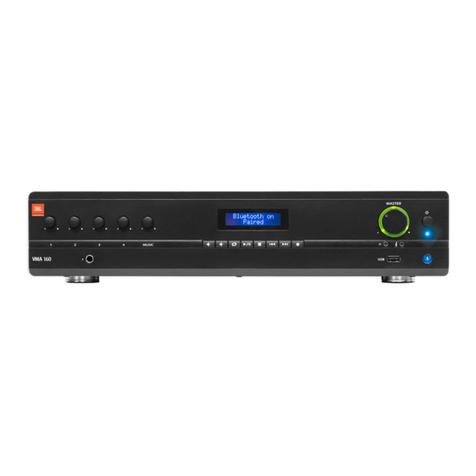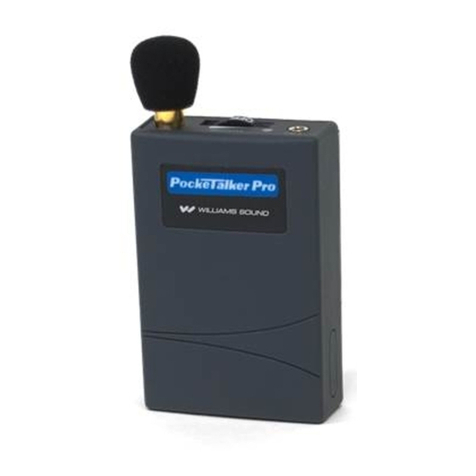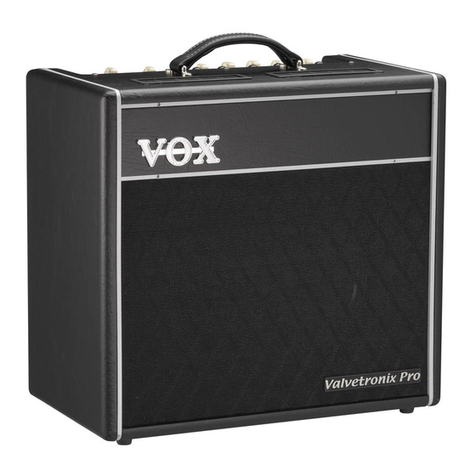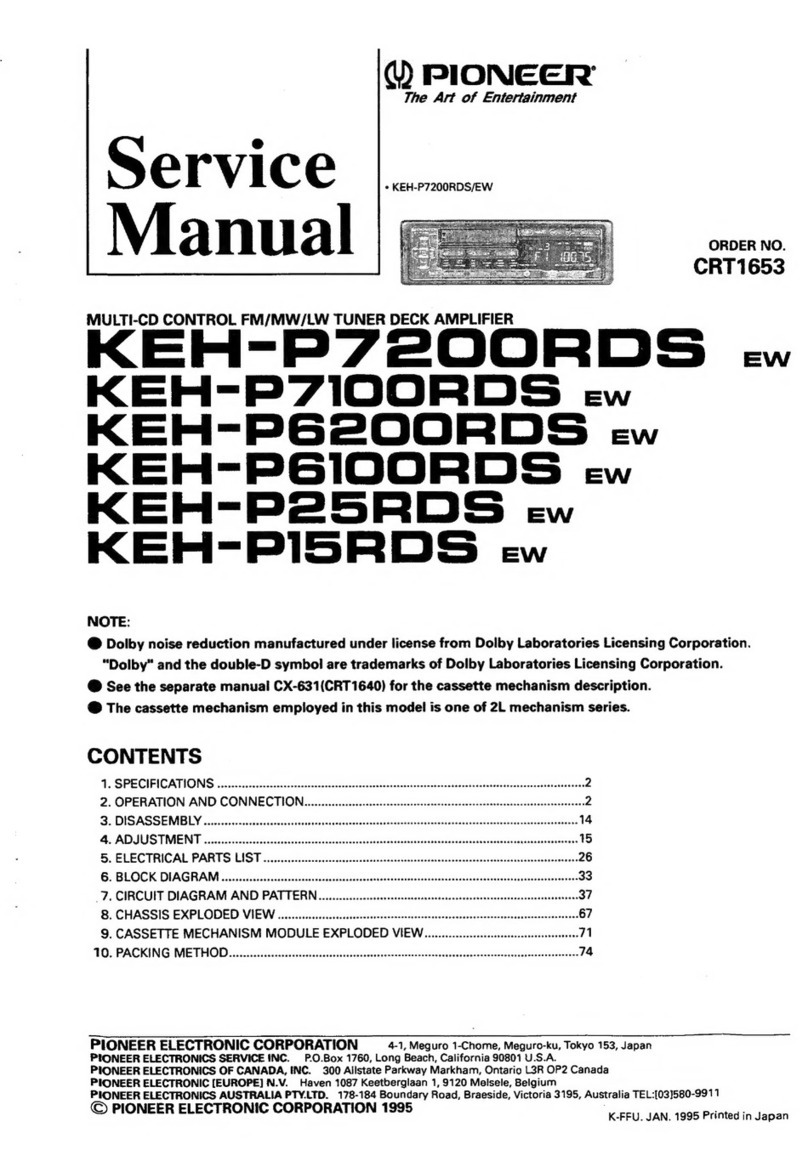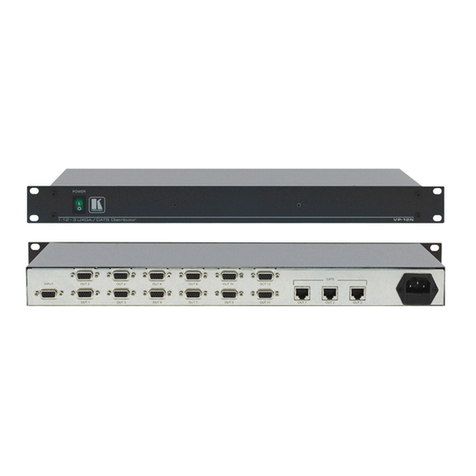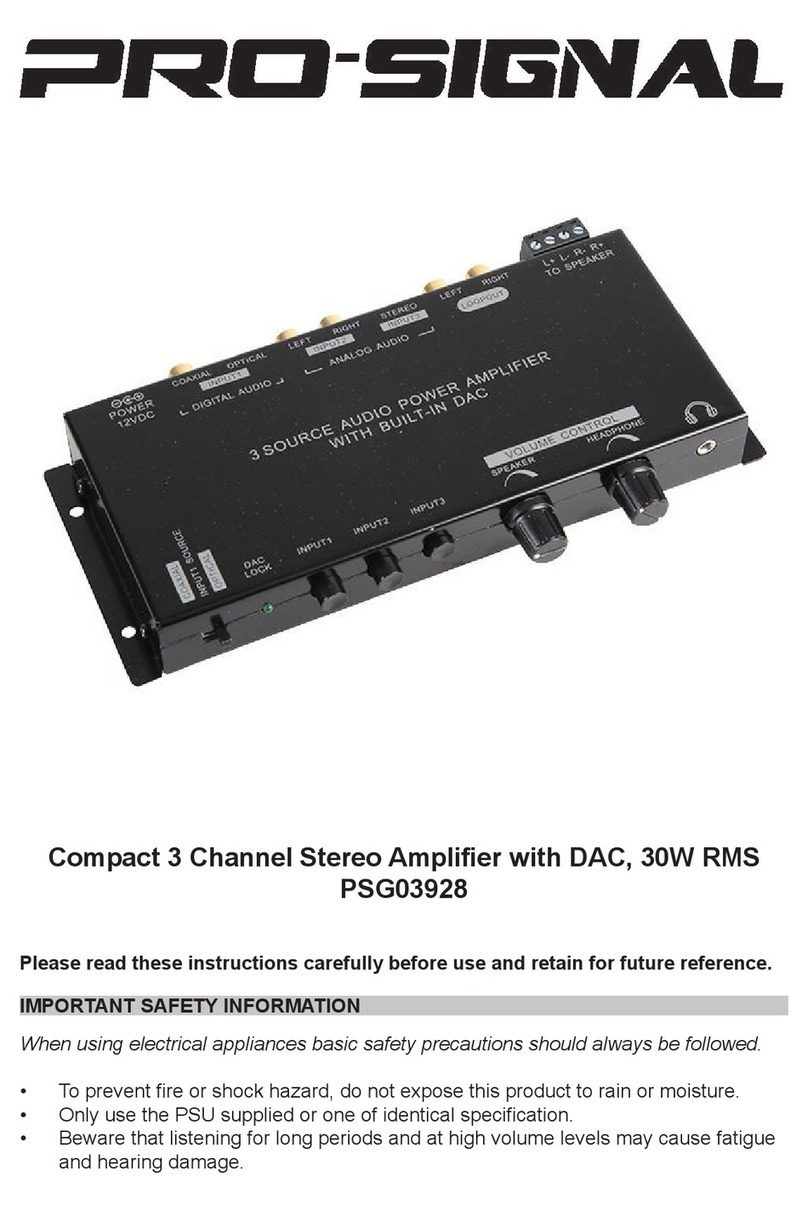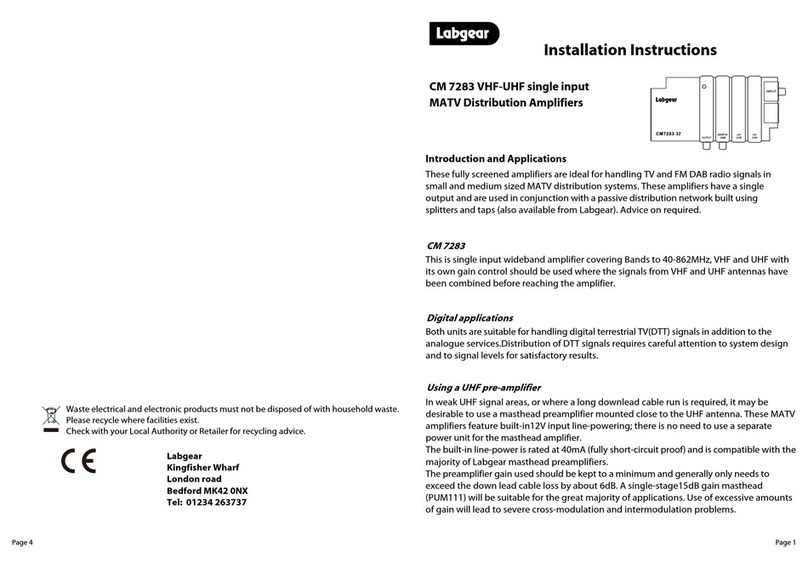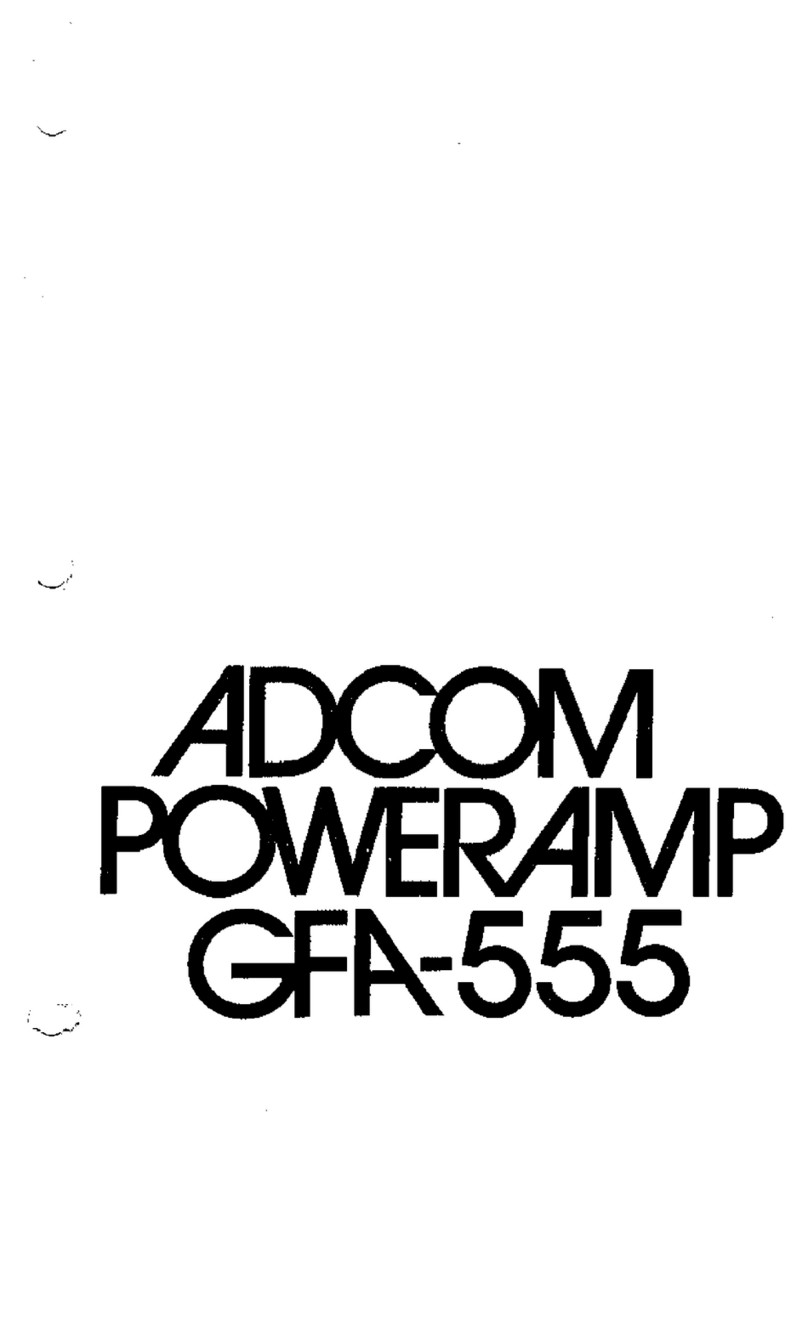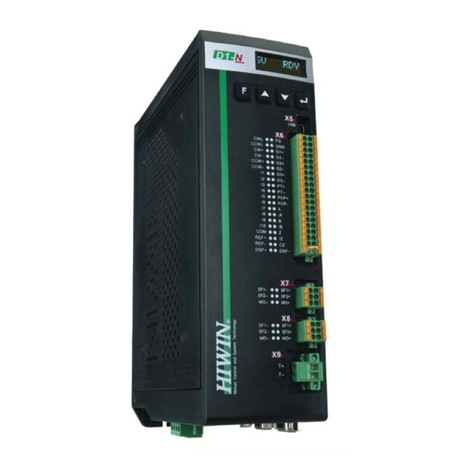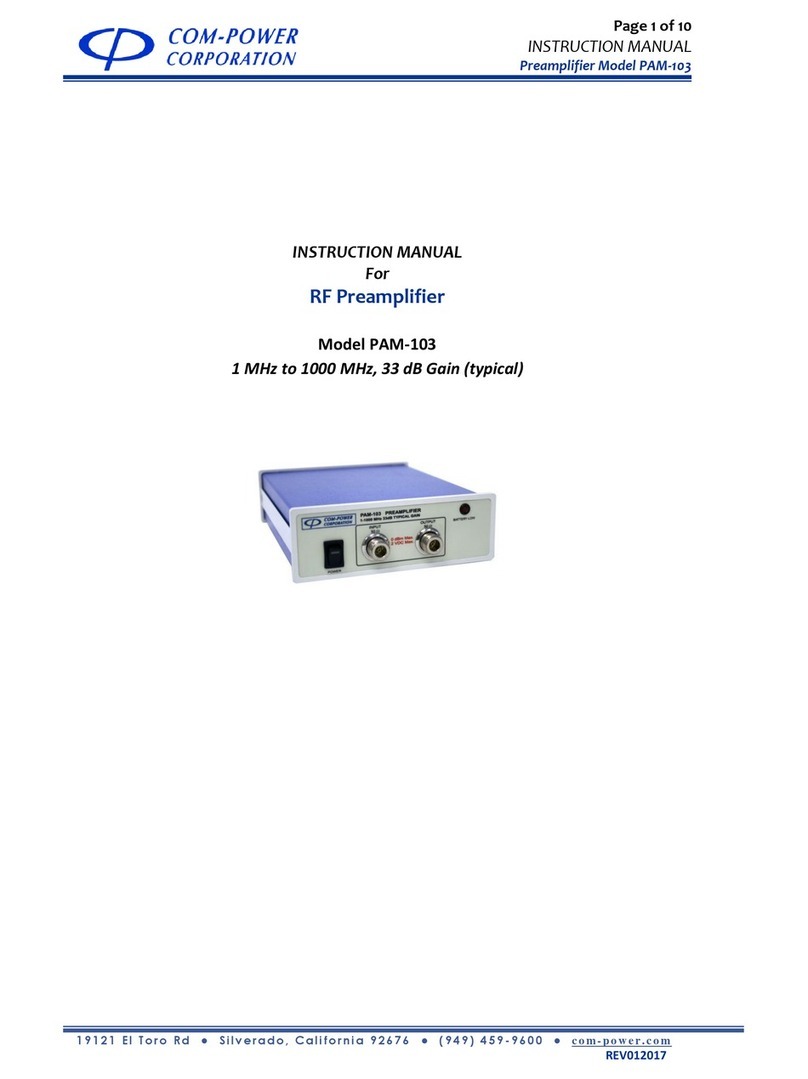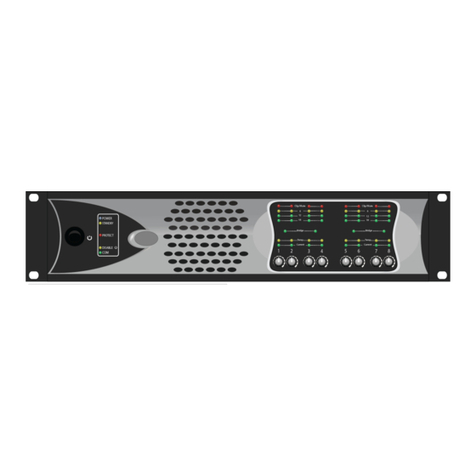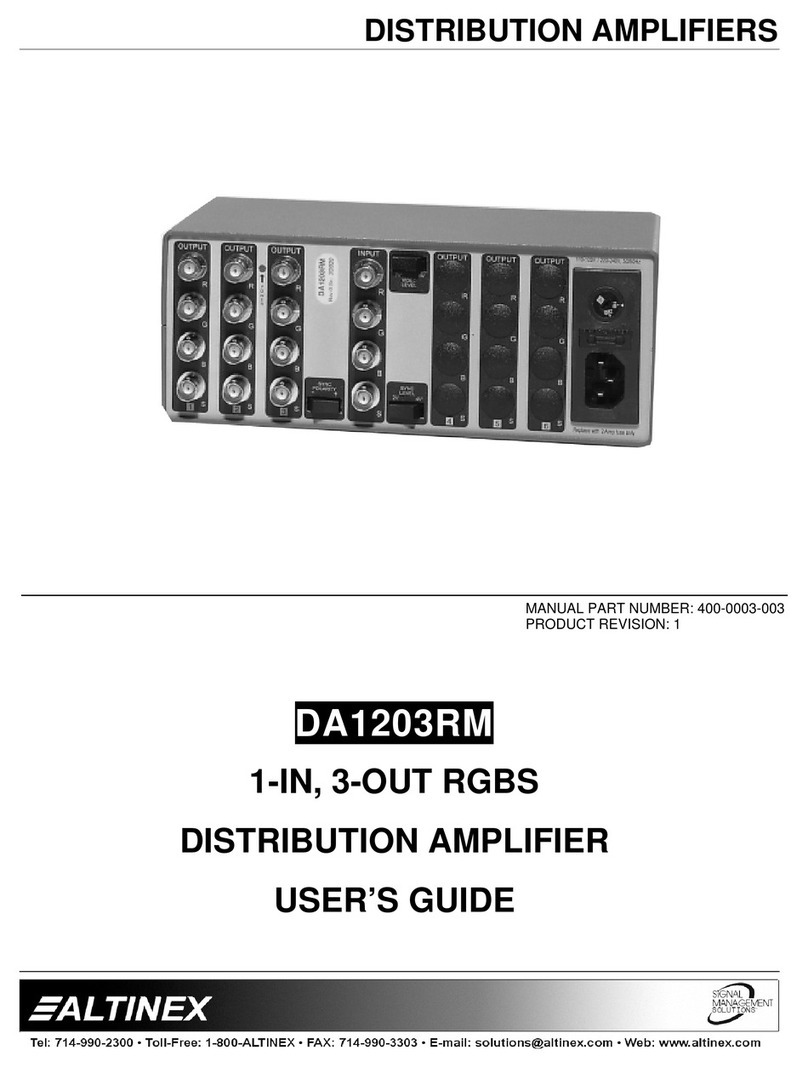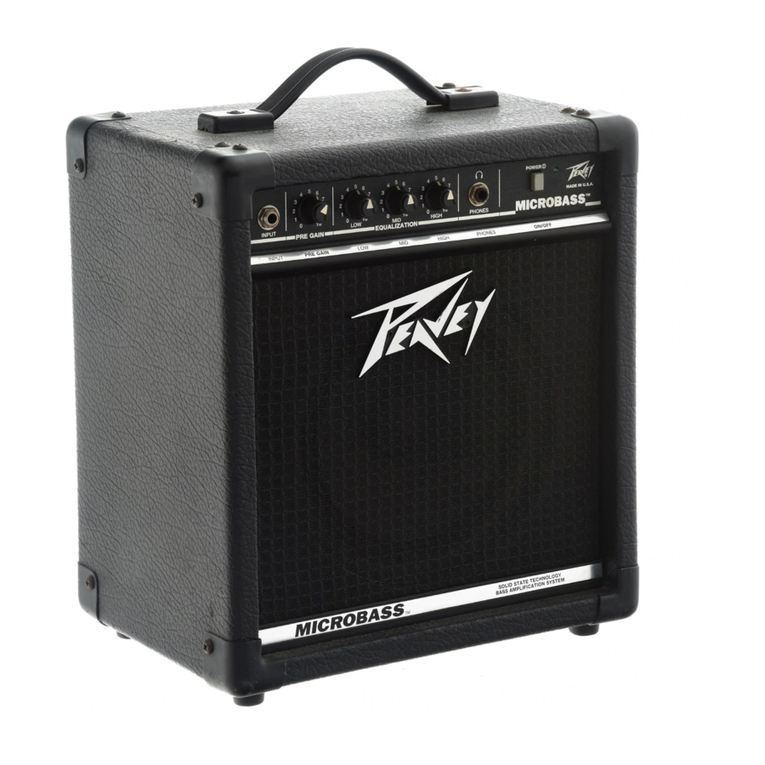Delta Tau Geo Brick User manual

^1 USER MANUAL
^2 Geo Brick
^3 Programmable Servo Amplifier
^4 5xx-603800-xUxx
^5 March 19, 2007
Single Source Machine Control Power // Flexibility // Ease of Use
21314 Lassen Street Chatsworth, CA 91311 // Tel. (818) 998-2095 Fax. (818) 998-7807 // www.deltatau.com

Copyright Information
© 2007 Delta Tau Data Systems, Inc. All rights reserved.
This document is furnished for the customers of Delta Tau Data Systems, Inc. Other uses are
unauthorized without written permission of Delta Tau Data Systems, Inc. Information contained in this
manual may be updated from time-to-time due to product improvements, etc., and may not conform in
every respect to former issues.
To report errors or inconsistencies, call or email:
Delta Tau Data Systems, Inc. Technical Support
Phone: (818) 717-5656
Fax: (818) 998-7807
Email: [email protected]
Website: http://www.deltatau.com
Operating Conditions
All Delta Tau Data Systems, Inc. motion controller products, accessories, and amplifiers contain static
sensitive components that can be damaged by incorrect handling. When installing or handling Delta Tau
Data Systems, Inc. products, avoid contact with highly insulated materials. Only qualified personnel
should be allowed to handle this equipment.
In the case of industrial applications, we expect our products to be protected from hazardous or
conductive materials and/or environments that could cause harm to the controller by damaging
components or causing electrical shorts. When our products are used in an industrial environment, install
them into an industrial electrical cabinet or industrial PC to protect them from excessive or corrosive
moisture, abnormal ambient temperatures, and conductive materials. If Delta Tau Data Systems, Inc.
products are directly exposed to hazardous or conductive materials and/or environments, we cannot
guarantee their operation.
Safety Instructions
Qualified personnel must transport, assemble, install, and maintain this equipment. Properly qualified
personnel are persons who are familiar with the transport, assembly, installation, and operation of
equipment. The qualified personnel must know and observe the following standards and regulations:
IEC 364 resp. CENELEC HD 384 or DIN VDE 0100
IEC report 664 or DIN VDE 0110
National regulations for safety and accident prevention or VBG 4
Incorrect handling of products can result in injury and damage to persons and machinery. Strictly adhere
to the installation instructions. Electrical safety is provided through a low-resistance earth connection. It
is vital to ensure that all system components are connected to earth ground.
This product contains components that are sensitive to static electricity and can be damaged by incorrect
handling. Avoid contact with high insulating materials (artificial fabrics, plastic film, etc.). Place the
product on a conductive surface. Discharge any possible static electricity build-up by touching an
unpainted, metal, grounded surface before touching the equipment.
Keep all covers and cabinet doors shut during operation. Be aware that during operation, the product has
electrically charged components and hot surfaces. Control and power cables can carry a high voltage,
even when the motor is not rotating. Never disconnect or connect the product while the power source is
energized to avoid electric arcing.

After removing the power source from the equipment, wait at least 10 minutes before touching or
disconnecting sections of the equipment that normally carry electrical charges (e.g., capacitors, contacts,
screw connections). To be safe, measure the electrical contact points with a meter before touching the
equipment.
The following text formats are used in this manual to indicate a potential for personal injury or equipment
damage. Read the safety notices in this manual before attempting installation, operation, or maintenance
to avoid serious bodily injury, damage to the equipment, or operational difficulty.
WARNING:
A Warning identifies hazards that could result in personal injury or death. It
precedes the discussion of interest.
Caution:
A Caution identifies hazards that could result in equipment damage. It precedes
the discussion of interest
Note:
A Note identifies information critical to the user’s understanding or use of the
equipment. It follows the discussion of interest.


REVISION HISTORY
REV. DESCRIPTION DATE CHG APPVD
1 UPDATED ANALOG INPUT SECTION 09/07/06 CP R. UNADKAT
2 UPDATED 6-AXIS REGEN RESISTOR INFO, P. 8 03/19/07 CP D. GENTRY


Geo Brick User Manual
Table of Contents i
Table of Contents
Copyright Information.............................................................................................................................................. ii
Operating Conditions ............................................................................................................................................... ii
Safety Instructions.................................................................................................................................................... ii
INTRODUCTION .......................................................................................................................................................1
Geo Brick Features....................................................................................................................................................1
Amplifier Standard Features ................................................................................................................................2
Amplifier Ratings..................................................................................................................................................2
Feedback Devices......................................................................................................................................................3
Compatible Motors....................................................................................................................................................3
Maximum Speed....................................................................................................................................................3
Torque...................................................................................................................................................................3
Motor Poles ..........................................................................................................................................................4
Motor Inductance..................................................................................................................................................4
Motor Resistance ..................................................................................................................................................4
Motor Back EMF ..................................................................................................................................................4
Motor Torque Constant ........................................................................................................................................4
Motor Inertia ........................................................................................................................................................5
Motor Cabling ......................................................................................................................................................5
SPECIFICATIONS .....................................................................................................................................................7
Part Number ..............................................................................................................................................................7
Geo Brick Options ................................................................................................................................................7
Environmental Specifications....................................................................................................................................8
Electrical Specifications............................................................................................................................................8
4-axis Configuration.............................................................................................................................................8
6-axis Configuration.............................................................................................................................................8
8-axis Configuration.............................................................................................................................................9
Recommended Fusing and Wire Gauge ....................................................................................................................9
Wire Sizes .............................................................................................................................................................9
Package Types.........................................................................................................................................................10
RECEIVING AND UNPACKING...........................................................................................................................11
Use of Equipment....................................................................................................................................................11
MOUNTING ..............................................................................................................................................................13
4-axis Low/Medium Power Drive...........................................................................................................................14
6-axis: 4-axis Low/Medium Power plus 2-axis High Power (15A/30A) Drive ......................................................15
8-axis Low/Medium Power Drive...........................................................................................................................16
SYSTEM WIRING....................................................................................................................................................17
Fuse and Circuit Breaker Selection....................................................................................................................17
Use of GFI Breakers...........................................................................................................................................18
Transformer and Filter Sizing ............................................................................................................................18
Noise Problems...................................................................................................................................................18
Operating Temperature ......................................................................................................................................18
Single Phase Operation ......................................................................................................................................18
Wiring AC Input......................................................................................................................................................19
J1: AC Input Connector Pinout .........................................................................................................................19
Wiring Earth-Ground ..............................................................................................................................................19
Earth Grounding Paths.......................................................................................................................................19
Wiring 24 V Logic Control .....................................................................................................................................20
J2: 24VDC Input Logic Supply Connector ........................................................................................................20
Wiring the Motors ...................................................................................................................................................20
A1-8: Motor 1 to 8 Output Connector Pinout (Low/Medium Power Units) ......................................................21
A5-6: Motor 5 and 6 High Power Option Connector Pinout.............................................................................21
Regen (Shunt) Resistor Wiring ...............................................................................................................................21

Geo Brick User Manual
ii Table of Contents
J3: External Shunt Connector Pinout ................................................................................................................22
Shunt Regulation.................................................................................................................................................22
Minimum Resistance Value.................................................................................................................................23
Maximum Resistance Value ................................................................................................................................23
Energy Transfer Equations.................................................................................................................................23
Bonding...................................................................................................................................................................26
Filtering...................................................................................................................................................................26
CE Filtering........................................................................................................................................................26
Input Power Filtering .........................................................................................................................................26
Motor Line Filtering ...........................................................................................................................................27
I/O Filtering........................................................................................................................................................27
Connectors...............................................................................................................................................................28
X1-X8: Encoder Input (1 to 8) ............................................................................................................................28
X9-10: Analog I/O Ch5 (X9) and Ch6 (X10), (Optional) ..................................................................................29
X11-12: Analog I/O Ch7 (X11) and Ch8 (X12), (Optional) ..............................................................................29
X13: USB 2.0 Connector ...................................................................................................................................30
X14: RJ45, Ethernet Connector.........................................................................................................................30
X15: Watchdog & ABORT..................................................................................................................................31
JPWR Power 4-Point Screw Terminal (Internal) ...............................................................................................31
J4 Limit Inputs (1-4 Axis) ...................................................................................................................................32
J5 Limit Inputs (5-8 Axis) ...................................................................................................................................33
J6: General Purpose I/O....................................................................................................................................35
Suggested M-Variable Addressing for the General Purpose I/O (J6) ................................................................36
J7: Extra General Purpose I/O (Optional) .........................................................................................................37
Suggested M-Variable Addressing for the optional General Purpose I/O (J7) ..................................................38
Setting up Quadrature Encoders..............................................................................................................................40
Signal Format .....................................................................................................................................................40
Hardware Setup..................................................................................................................................................40
Encoder Loss Setup.............................................................................................................................................41
Setting Up Digital Hall Sensors ..............................................................................................................................42
Signal Format .....................................................................................................................................................42
Hardware Setup..................................................................................................................................................42
Using Hall Effect Sensors for Phase Reference..................................................................................................43
Determining the Commutation Phase Angle.......................................................................................................43
Finding the Hall Effect Transition Points...........................................................................................................43
Calculating the Hall Effect Zero Point (HEZ) ....................................................................................................44
Determining the Polarity of the Hall Effects – Standard or Reversed................................................................46
Software Settings for Hall Effect Phasing...........................................................................................................47
Optimizing the Hall Effect Phasing Routine for Maximum Performance...........................................................48
Using the Test Results.........................................................................................................................................49
Setting Up the Analog Inputs (optional) .............................................................................................................52
Filtered DAC Outputs Configuration .................................................................................................................55
Setting up for Pulse and Direction Output...............................................................................................................56
Software Setup ....................................................................................................................................................56
DIRECT PWM COMMUTATION CONTROLLER SETUP ................................................................................60
Key Servo IC Variables...........................................................................................................................................60
Key Motor Variables...............................................................................................................................................60
DC BRUSH MOTOR DRIVE SETUP WITH TURBO PMAC ............................................................................61
Commutation Phase Angle: Ixx72...........................................................................................................................61
Special Instructions for Direct-PWM Control of Brush Motors..............................................................................61
Testing PWM and Current Feedback Operation .....................................................................................................62
Purpose...............................................................................................................................................................63
Preparation.........................................................................................................................................................63
Position Feedback and Polarity Test..................................................................................................................64
PWM Output and ADC Input Connection ..............................................................................................................64

Geo Brick User Manual
Table of Contents iii
PWM/ADC Phase Match ....................................................................................................................................65
Synchronous Motor Stepper Action ....................................................................................................................65
Current Loop Polarity Check .............................................................................................................................65
Troubleshooting..................................................................................................................................................65
Setting I2T Protection ..............................................................................................................................................66
Calculating Minimum PWM Frequency .................................................................................................................67
Amplifier Only Special online commands ..............................................................................................................68
AMPVERSION....................................................................................................................................................68
AMPMOD...........................................................................................................................................................68
PWM DRIVE COMMAND STRUCTURE.............................................................................................................71
Default Mode...........................................................................................................................................................71
Enhanced Mode.......................................................................................................................................................71
TROUBLESHOOTING............................................................................................................................................73
Error Codes .............................................................................................................................................................73
D1: Geo Brick Drive Status Display Codes........................................................................................................73
Status LEDs ........................................................................................................................................................74
Actions on Watchdog Timer Trip........................................................................................................................75
Diagnosing Cause of Watchdog Timer Trip .......................................................................................................75
APPENDIX A.............................................................................................................................................................77
Mating Connector and Cable Kits ...........................................................................................................................77
CONKIT5A .........................................................................................................................................................78
CONKIT5B .........................................................................................................................................................78
CONKIT5C .........................................................................................................................................................78
PWM Cable Ordering Information..........................................................................................................................79
Cable Drawings.......................................................................................................................................................80
5A/10A and 8A/16A Motor Cable.......................................................................................................................80
15A/30A Motor Cable.........................................................................................................................................81
24V Logic Power Cable......................................................................................................................................82
3-Phase power cable...........................................................................................................................................83
Regenerative Resistor: GAR48/78 .....................................................................................................................83
Regenerative Resistor: GAR48/78 .....................................................................................................................84
DB- Connector Spacing Specifications ...................................................................................................................85
X1-8: DB-15 Connectors for encoder feedback..................................................................................................85
X9-12: DB-9 Connectors for Analog I/O............................................................................................................85
Screw Lock Size for all DB-connectors ..............................................................................................................85
Type of Cable for Encoder Wiring..........................................................................................................................86
APPENDIX B.............................................................................................................................................................88
Schematics...............................................................................................................................................................88
X15: Watchdog ..................................................................................................................................................88
J6 and J7: General Purpose I/O........................................................................................................................88
J4: Limit Inputs for Axis 1-4 ..............................................................................................................................90
J5: Limit Inputs for Axis 5-8 ..............................................................................................................................91
APPENDIX C.............................................................................................................................................................92
Board Jumpers.........................................................................................................................................................92
E10 – E12: Power-Up/Reset Load Source .............................................................................................................92
E13: Firmware Reload Enable................................................................................................................................92
E14: Watchdog Disable Jumper .............................................................................................................................92
E25-28: Select Encoder Index input or AENA output (channels 1-4)....................................................................93
E35-39: Select Encoder Index input or AENA output (channels 5-8)....................................................................93
E3: Re-Initialization on Reset Control ...................................................................................................................93


Geo Brick User Manual
Introduction 1
INTRODUCTION
The Geo Brick combines the intelligence and capability of the Turbo PMAC2
motion controller with the latest IGBT-based drive technology, resulting in a
compact, smart 4-, 6- or 8-axis servo drive package. The flexibility of the
Turbo PMAC2 enables the Geo Brick to drive Brush, Brushless or AC
induction motors with unsurpassed pure digital DSP performance. The absence
of analog signals – required for typical motion controller/drive interfacing –
enables higher gains, better overall performance and tighter integration, while
significantly driving down costs and setup time.
The Geo Brick’s embedded 32-axis Turbo PMAC2 motion controller is
programmable for virtually any kind of motion control application. The unit’s
PLC programming features allow for complete machine logic control.
The Geo Brick’s drive and motion controller are seamlessly integrated. All
diagnostic information (amplifier faults, bus voltage, axis currents, phase
current, heatsink temperature, etc.) is accessed by the PMAC and available to
user-written PMAC programs (due to be released soon).
The Geo Brick is a fully scaleable automation controller, especially for
applications requiring only I/O-driven smart servo control where motion is
coordinated by a machine controller (such as a PLC). With the ability to store
programs locally and execute based on inputs, Ethernet or high-speed USB 2.0-
based communication, the Geo Brick is an ideal solution.
Geo Brick Drive
The Geo Brick’s functionality doesn’t stop there. For applications requiring a complete machine
controller with PLC functionality, motion control, extensible I/O via Modbus TCP master, an HMI
terminal via Modbus TCP slave or even a PC-based HMI package connected via USB 2.0 or Ethernet, the
Geo Brick is again the answer.
Geo Brick Features
The Geo Brick is capable of controlling up to eight axes with direct-PWM commands.
• Motorola DSP 56k digital signal processor
• Turbo PMAC2 CPU (for kinematics, open servo, NC applications)
• Fully Configurable via USB2.0 and/or Ethernet TCP/IP (100 Base-T)
• Operation from a PC
• Stand-alone operation
• Linear and circular interpolation
• 256 motion programs capacity
• 64 asynchronous PLC program capability
• Rotating buffer for large programs
• 36-bit position range (± 64 billion counts)
• Adjustable S-curve acceleration and deceleration
• Cubic trajectory calculations, splines
• Set and change parameters in real time
• Torque, Velocity and Position control standard
• Small footprint saves space
• Full rated temperature cooling standard (no need for additional fans)
• 16 inputs (expandable to 32 with option) fully-protected and isolated with separate commons for
two banks of eight

Geo Brick User Manual
2Introduction
• Eight thermal-fuse protected outputs (expandable to 16 with option) rated for 0.5A @ 24VDC
each (Flexible outputs allow for sinking or sourcing of current depending on whether the common
emitter or common collector is used.)
• Primary encoder for each axis with TTL differential/single-ended inputs with A, B quadrature
channels and C index channel, 10 MHz cycle rate, and digital Hall-effect inputs
• Five flags per axis using DB-25: HOME, PLIM, MLIM and USER inputs; EQU compare outputs
for first four axes and five more flags per axis if the 6 or 8-axis system is ordered
• Optional analog inputs and outputs, ± 5VDC
• Optional two PWM outputs.
• Optional Dual Port RAM (Required for NC)
• Optional Modbus Protocol
• Optional Sinusoidal encoder feedback*
• Optional Resolver feedback*
• Optional EnDat, Hiperface interfaces.*
*availability expected in the third quarter of 2006
Amplifier Standard Features
• 4-, 6- or 8-channel direct PWM input from controller
• Integral 4-, 6- or 8-axis servo amplifier delivering from 5A cont./10A peak to 15A cont./30A peak per
axis (limited to two axes per drive @ 15/30A)
• Four pin locking connector contacts for motor outputs and 3-phase AC input power and earth ground
terminations
• Complete protection: over voltage, under voltage, heatsink and IGBT over temperature, short circuit,
over current, input phase loss detection, shunt over-current detection
• Two contacts for shunt regulator resistor termination. (Connector type is locking style.)
• Integrated bus power supply including shunt regulator (GAR48 or GAR78 external resistor required)
Amplifier Ratings
• Output Current:
5A Continuous, 10A Peak (two seconds), RMS.
8A Continuous, 16A Peak (two seconds), RMS**
15A Continuous, 30A Peak (two seconds), RMS**
**availability expected in the first quarter of 2006
• Output Power:
• 5/10A unit is rated for 1247 watts per axis (based on modulation depth of 60% rms)
• 8/16A unit is rated for 1995 watts per axis (based on modulation depth of 60% rms)
• 15/30A unit is rated for 3741 watts per axis (based on modulation depth of 60% rms)
• Input Current:
• 5/10A 4-axis unit 13 A(rms)/phase (3-phase) @ 240 VAC Input
• 8/16A 4-axis unit 21 A(rms)/phase (3-phase) @ 240 VAC Input
• 15/30A 2-axis unit 20 A(rms)/phase (3-phase) @ 240 VAC Input
• Universal AC input 97-265 VAC, or DC operation from 12VDC to 340VDC.

Geo Brick User Manual
Introduction 3
Feedback Devices
Many motors incorporate a position feedback device. Devices are incremental encoders, resolvers, and
sine encoder systems. The Geo Brick is set up to accept incremental encoder feedback.
Historically, the choice of a feedback device has been guided largely by cost and robustness factors.
Today, feedbacks are relatively constant for the cost and picked by features such as size and feedback
data. More feedback data or resolution provides the opportunity to have higher gains in a servo system.
Geo Brick at its 4-axis version can be ordered with two (Opt-01) or four (Opt-02) secondary quadrature
encoders. The 8-axis version of the Geo Brick does not have the option for secondary encoders; it comes
standard with eight incremental digital encoders and flags for each axis.
Compatible Motors
The Geo Brick product line is capable of interfacing to a wide variety of motors. The Geo Brick can
control almost any type of three-phase brushless motor, including DC brushless rotary, AC brushless
rotary, induction, and brushless linear motors. Permanent magnet DC brush motors can also be controlled
using two of the amplifiers three phases. Motor selection for an application is a science in itself and
cannot be covered in this manual. However, some basic considerations and guidelines are offered. Motor
manufacturers include a host of parameters to describe their motor.
Some basic equations can help guide an applications engineer to mate a proper drive with a motor. A
typical application accelerates a load to a speed, running the speed for a while and then decelerating the
load back into position.
Maximum Speed
The motor’s maximum rated speed is given. This speed may or may not be achievable in a given system.
The speed could be achieved if enough voltage and enough current loop gain are available. Also,
consider the motor’s feedback adding limitations to achievable speeds. The load attached to the motor
also limits the maximum achievable speed. In addition, some manufacturers will provide motor data with
their drive controller, which is tweaked to extend the operation range that other controllers may be able to
provide. In general, the maximum speed can be determined by input voltage line-to-line divided by Kb
(the motor’s back EMF constant). It is wise to de-rate this a little for proper servo applications.
Torque
The torque required for the application can be viewed as both instantaneous and average. Typically, the
instantaneous or peak torque is calculated as a sum of machining forces or frictional forces plus the forces
required to accelerate the load inertia. The machining or frictional forces on a machine must be
determined by the actual application. The energy required to accelerate the inertia follows the equation:
T = JA, where T is the torque in Newton-meters or pound-feet required for the acceleration, J is the inertia
in kilogram-meters-squared or pound-feet-second-squared, and A is in radians per second per second.
The required torque can be calculated if the desired acceleration rate and the load inertia reflected back to
the motor are known. The T=JA equation requires that the motor’s inertia be considered as part of the
inertia-requiring torque to accelerate.
Once the torque is determined, the motors specification sheet can be reviewed for its torque constant
parameter (Kt). The torque required at the application divided by the Kt of the motor provides the peak
current required by the amplifier. A little extra room should be given to this parameter to allow for good
servo control.
Most applications have a duty cycle in which the acceleration profile occurs repetitively over time.
Calculating the average value of this profile gives the continuous rating required by the amplifier.
Applications also concern themselves with the ability to achieve a speed. The requirements can be
reviewed by either defining what the input voltage is to the drive, or defining what the voltage
requirements are at the motor. Typically, a system is designed at a 230 or 480V input line. The motor

Geo Brick User Manual
4Introduction
must be able to achieve the desired speed with this voltage limitation. This can be determined by using
the voltage constant of the motor (Kb), usually specified in volts-per-thousand rpm. The application
speed is divided by 1000 and multiplied by the motor’s Kb. This is the required voltage to drive the
motor to the desired velocity. Headroom of 20% is suggested to allow for good servo control.
Peak Torque
The peak torque rating of a motor is the maximum achievable output torque. It requires that the amplifier
driving it be able to output enough current to achieve this. Many drive systems offer a 3:1 peak-to-
continuous rating on the motor, while the amplifier has a 2:1 rating. To achieve the peak torque, the drive
must be sized to be able to deliver the current to the motor. The required current is often stated on the
datasheet as the peak current through the motor. In some sense, it can also be determined by dividing the
peak amplifier's output rating by the motor’s torque constant (Kt).
Continuous Torque
The continuous torque rating of the motor is defined by a thermal limit. If more torque is consumed from
the motor than this on average, the motor overheats. Again, the continuous torque output of the motor is
subject to the drive amplifier’s ability to deliver that current. The current is determined by the
manufacturer’s datasheets stating the continuous RMS current rating of the motor and can also be
determined by using the motor’s Kt parameter, usually specified in torque output per amp of input current.
Motor Poles
Usually, the number of poles in the motor is not a concern to the actual application. However, it should
be noted that each pole-pair of the motor requires an electrical cycle. High-speed motors with high motor
pole counts can require high fundamental drive frequencies that a drive amplifier may or may not be able
to output. In general, drive manufacturers with PWM switching frequencies (16kHz or below) would like
to see commutation frequencies less than 400 Hz. The commutation frequency is directly related to the
number of poles in the motor.
Motor Inductance
PWM outputs require significant motor inductance to turn the on-off voltage signals into relatively
smooth current flow with small ripple. Typically, motor inductance of servomotors is 1 to 15 mH. The
Geo drive product series can drive this range easily. On lower-inductance motors (below 1mH), problems
occur due to PWM switching where large ripple currents flow through the motor, causing excessive
energy waste and heating. If an application requires a motor of less than 1mH, external inductors are
recommended to increase that inductance. Motors with inductance in excess of 15mH can still be driven,
but are slow to react and typically are out of the range of high performance servomotors.
Motor Resistance
Motor resistance is not really a factor in determining the drive performance, but rather, comes into play
more with the achievable torque or output horsepower from the motor. The basic resistance shows up in
the manufacturer’s motor horsepower curve.
Motor Back EMF
The back EMF of the motor is the voltage that it generates as it rotates. This voltage subtracts from the
bus voltage of the drive and reduces the ability to push current through the motor. Typical back EMF
ratings for servomotors are in the area of 8 to 200 volts-per-thousand rpm. The Geo drive product series
can drive any range of back EMF motor, but the back EMF is highly related to the other parameters of the
motor such as the motor inductance and the motor Kt. It is the back EMF of the motor that limits the
maximum achievable speed and the maximum horsepower capability of the motor.
Motor Torque Constant
Motor torque constant is referred to as Kt and usually it is specified in torque-per-amp. It is this number
that is most important for motor sizing. When the load that the motor will see and the motor’s torque

Geo Brick User Manual
Introduction 5
constant is known, the drive amplifier requirements can be calculated to effectively size a drive amplifier
for a given motor. Some motor designs allow Kt to be non-linear, in which Kt will actually produce less
torque per unit of current at higher output speeds. It is wise to de-rate the systems torque producing
capability by 20% to allow headroom for servo control.
Motor Inertia
Motor inertia comes into play with motor sizing because torque to accelerate the inertia of the motor is
effectively wasted energy. Low inertia motors allow for quicker acceleration. However, consider the
reflected inertia from the load back to the motor shaft when choosing the motor’s inertia. A high ratio of
load-to-motor inertia can limit the achievable gains in an application if there is compliance in the
transmission system such as belt-drive systems or rubber-based couplings to the systems. The closer the
rotor inertia matches the load’s reflected inertia to the motor shaft, the higher the achievable gains will be
for a given system. In general, the higher the motor inertia, the more stable the system will be inherently.
Mechanical gearing is often placed between the load and the motor simply to reduce the reflected inertia
back to the motor shaft.
Motor Cabling
Motor cables are an integral part of a motor drive system. Several factors should be considered when
selecting motor cables. First, the PWM frequency of the drive emits electrical noise. Motor cables must
have a good-quality shield around them. The motor frame must also have a separate conductor to bring
back to the drive amplifier to help quench current flows from the motor due to the PWM switching noise.
Both motor drain wire and the cable shield should be tied at both ends to the motor and to the drive
amplifier.
Another consideration in selecting motor cables is the conductor-to-conductor capacitance rating of the
cable. Small capacitance is desirable. Longer runs of motor cable can add motor capacitance loading to
the drive amplifier causing undesired spikes of current. It can also cause couplings of the PWM noise
into the earth grounds, causing excessive noise as well. Typical motor cable ratings would be 50 pf per
foot maximum cable capacitance.
Another factor in picking motor cables is the actual conductor cross-sectional area. This refers to the
conductors ability to carry the required current to and from the motor. When calculating the required
cable dimensions, consider agency requirements, safety requirements, maximum temperature that the
cable will be exposed to, the continuous current flow through the motor, and the peak current flow
through the motor. Typically, it is not suggested that any motor cable be less than 14 AWG.
The motor cable’s length must be considered as part of the application. Motor cable length affects the
system in two ways. First, additional length results in additional capacitive loading to the drive. The
drive’s capacitive loading should be kept to no more than 1000 pf. Additionally, the length sets up
standing waves in the cable, which can cause excessive voltage at the motor terminals. Typical motor
cable length runs of up to 60 meters (200 feet) for 230V systems and 15 meters (50 feet) for 480V
systems are acceptable. Exceeding these lengths may put other system requirements in place for either a
snubber at the motor end or a series inductor at the drive end. The series inductor at the drive end
provides capacitance loading isolation from the drive and slows the rise time of the PWM signal into the
cable, resulting in less voltage overshoot at the motor.

Geo Brick User Manual
6Introduction

Geo Brick User Manual
Specifications 7
SPECIFICATIONS
Part Number
GB L 0 00 00C
CPU Options - Turbo PMAC 2 Processor
C0: 80Mhz, 8Kx24 Internal, 256Kx24SRAM, 1MB Flash (Default)
C3: 80Mhz, 8Kx24 Internal, 512x24SRAM, 4MB Flash
E0: 160Mhz, 128Kx24 Internal, 256Kx24SRAM, 1MB Flash
E3: 160Mhz, 128Kx24 Internal, 1Mx24SRAM, 4MB Flash
F0: 240Mhz, 192Kx24 Internal, 256Kx24SRAM, 1MB Flash
F3: 240Mhz, 192Kx24 Internal, 1Mx24SRAM, 4MB Flash
5
Axes 1 to 4 Options
5:
5A/10A, with encoders and Flags for every axis(Default)
8:
8A/16A, with encoders and Flags for every axis
(Continuous/ Peak)
00 / 05:No options, 4-axis system , 12-24V flags (Default) / 5V flags
01 / 06:Two secondary encoder inputs (total of 6 encoder inputs), 12-24V Flag inputs / 5V flags
02 / 07:Four secondary encoders inputs (total of 8 encoder inputs), 12-24V Flag inputs / 5V flags
P1 /P6: PWM amplifier Interface for channels 7 and 8 with encoders for axes 7 and 8, 12-24V Flag inputs / 5V flags
P2 /P7:PWM amplifier Interface for channels 7 and 8 with encoders for axes 5 to 8 ( 2 secondary encoders),
12-24V Flag inputs / 5V flags
Communication Options
0
: No options (Default)
D
: DPR option (required for NC)
M
: ModBus option
S
: ModBus & DPR options combined
0: No options (Default)
1: Two 12-bit analog inputs & two analog outputs
2: Four 12-bit analog inputs & four analog outputs
3: Two Hi-Res Analog Inputs (16-bit) & two analog outputs
4: Four Hi-Res Analog Inputs (16-bit) & four analog outputs
---
0
4
Number of Amplifier Axes
4 :
Four Axes (Default)
6 :
Six Axes
8 :
Eight Axes
Geo Brick Drive
Part Number Definition
8
00 / 05
01 / 06
02 / 07
F1 / F6
F2 / F7
P1 / P6
P2 / P7
52 / 57
82 / 87
W2 / W 7
0: No options (Default)
1: Two 12-bit analog inputs & two analog outputs
3: Two Hi-Res Analog Inputs (16-bit) & two analog outputs
0: No options (Default)
6: Two 12-bit analog inputs & two analog outputs
7: Two Hi-Res Analog Inputs (16-bit) & two analog outputs
Note: Analog outputs are 12-bit filtered PWM outputs
6
4
52 /57:5-8 axis, 5A/10A, with encoder inputs for all axes, 12-24V Flag inputs / 5V flags
82 /87:5-8 axis, 8A/16A, with encoder inputs for all axes, 12-24V Flag inputs / 5V flags
F1 /F6: 5 and 6 axis, 15A/30A, with encoders for channels 5 & 6, 12-24V Flag inputs / 5V flags
F2 /F7:5 and 6 axis, 15A/30A, with encoders for channels 5 to 8 (2 secondary encoders), 12-24V Flag inputs / 5V flags
W2 /W7: Combines Option P1/P6 and F1/F6 (Hi-Power 5 & 6 axes, plus PWM amplifier Interface for channels 7 and 8),
12-24V Flag inputs / 5V flags
Axes 5 to 8 Options
If user wants to or der 5V flag inputs then he needs to specify it at the Axes 5 to 8 opti ons
For example :
“06" Two secondar y encoder inputs ( total of 6 encoder inputs ), 5V Fl ag i nputs
“W 7” C om bi nes Option P6 and F6 (Hi-Power 5 & 6 axes , plus PWM amplifi er Inter face for channels 7 and 8), 5V Flag inputs
If the above Number of Amplifier Axesare selected then only the
corresponding Axes 5 to 8 Options are available.
If the above Axes 5 to 8 optionsare selected, then only the
corresponding Analog I/O options are available
0: No Analog Options available, for this configurations
Digital I /O Option
0:
No Options (Default)
1:
Expanded digital I/O, additional16 inputs and8 outputs
Outputs are rated: 0.5A@12-24VDC
Analog I/O Options
Geo Brick Options
CPU Options
• Option C3 – 80MHz Turbo CPU with 8Kx24 internal memory, 1Mx24 SRAM, 4Mx8 flash memory
• Option E0 – 160MHz Turbo CPU with 128Kx24 internal memory, 256Kx24 SRAM, 1Mx8 flash memory
• Option E3 – 160MHz Turbo CPU with 128Kx24 internal memory, 1Mx24 SRAM, 4Mx8 flash memory
• Option F0 – 240MHz Turbo CPU with 192Kx24 internal memory, 256Kx24 SRAM, 1Mx8 flash memory
• Option F3 – 240MHz Turbo CPU with 192Kx24 internal memory, 1Mx24 SRAM, 4Mx8 flash memory
Secondary Encoder Options
• Two secondary encoder inputs, and flags for all 8 channels
• Two additional secondary encoder inputs for a total of four.
Note: For six axis units only two secondary encoders can be ordered. For the eight axes units all
secondary encoders are used as primary encoders.
Input Output Options
• Additional 16 inputs and 8 outputs, 0.5A @ 24VDC.
• Analog I/O using two DB9 connectors will provide access to two analog inputs and two analog
outputs. The analog inputs are 12-bit resolution A/D. The analog outputs are 12-bit filtered PWM.
Additionally, two Amp Enable and two Amp Fault outputs are provided.
• Option to increase the analog inputs and outputs from two to four (12-bit).
• Option for Hi-Resolution analog inputs (16-bit). The Analog outputs remain 12-bit filtered PWM.
Communication Options
• Option D – small DPRAM 8K x 16-bit wide required for use with NC software
• Option M – Modbus Communication Protocol
• Option S – Option D (DPR) and Option M combined.

Geo Brick User Manual
8Specifications
Environmental Specifications
Description Unit Specifications
Operating Temperature °C +0 to 45°C. Above 45°C, derate the continuous peak output current
by 2.5% per °C above 45°C. Maximum Ambient is 55°C
Rated Storage Temperature °C -25 to +70
Humidity % 10% to 90% non-condensing
Shock Call Factory
Vibration Call Factory
Operating Altitude Feet
(Meters)
To 3300 feet (1000 meters). Derate the continuous and peak output
current by 1.1% for each 330 feet (100meters) above the 3300 feet
Air Flow Clearances in (mm) 3" (76.2mm) above and below unit for air flow
Electrical Specifications
4-axis Configuration
Model GBL4-xx-50x-xxx GBL4-xx-80x-xxx
Output Continuous Current (rms/axis) 5A 8A
Output Peak Current for 2 seconds (rms/axis) 10A 16A
Rated Input Power (KVA) @ 240VAC 13A (for all axes) 21A (for all axes)
1247W/axis 1995W/axis
Output Power (Watts per axis)
(based on modulation depth of 60% RMS)
Total 4988W 7980W
Power Dissipation (Watts) 498W 798W
Recommended PWM Frequency Mean/Max (kHz) 10/12 Not released
AC Input Line Voltage (VAC rms) 97-265 VAC 3 phase
DC Input Line Voltage (VDC) 12VDC to 340VDC
Logic Power (VDC, A) 24VDC, 2A
Continuous Regen Power rating (Watts) 4800W
Peak Regen Power rating (Watts) 9600W
Recommended Regen Resistor GAR 78
6-axis Configuration
GBL6-xx-5Fx-xxx GBL6-xx-8Fx-xxx
Model 1-4 axis 5-6 axis 1-4 axis 5-6 axis
Output Continuous Current (rms/axis) 5A 15A 8A 15A
Output Peak Current for 2 seconds (rms/axis) 10A 30A 16A 30A
Rated Input Power (KVA) @ 240VAC 33A (for all axes) 41A (for all axes)
1247
W/axis
3741
W/axis
1995
W/axis
3741
W/axis
Output Power (Watts per axis)
(based on modulation depth of 60% RMS)
Total 12470W 15462W
Power Dissipation (Watts) 1247W 1546W
Recommended PWM Frequency Mean/Max (kHz) Not released Not released
AC Input Line Voltage (VAC rms) 97-265 VAC 3 phase
DC Input Line Voltage (VDC) 12VDC to 340VDC
Logic Power (VDC, A) 24VDC, 3A
Continuous Regen Power rating (Watts) 6000W
Peak Regen Power rating(Watts) 12000W
Recommended Regen Resistor GAR 48-3

Geo Brick User Manual
Specifications 9
8-axis Configuration
GBL8-xx-552-
xxx
GBL8-xx-882-
xxx
GBL8-xx-582-
xxx
GBL8-xx-852-
xxx
Model 1-4
axis
5-8
axis
1-4
axis
5-8
axis
1-4
axis
5-8
axis
1-4
axis
5-8
axis
Output Continuous Current
rms/axis) 5A 5A 8A 8A 5A 8A 8A 5A
Output Peak Current for 2 seconds
(rms/axis) 10A 10A 16A 16A 10A 16A 16A 10A
Rated Input Power (KVA) @
240VAC 26A (for all axes) 42A (for all axes) 34A (for all axes) 34A (for all axes)
1247 W/axis 1995 W/axis 1247
W/axis
1995
W/axis
1995
W/axis
1247
W/axis
Output Power (Watts per axis)
(based on modulation depth of 60%
RMS)
Total 9976W 15960W 12968W 12968W
Power Dissipation (Watts) 998W 1596W 1297W 1297W
Recommended PWM Frequency
Mean/Max (kHz)
Not released Not released Not released Not released
AC Input Line Voltage (VAC rms) 97-265 VAC 3 phase
DC Input Line Voltage (VDC) 12VDC to 340VDC
Logic Power (VDC, A) 24VDC, 4A
Continuous Regen Power (Watts) 4800W
Peak Regen Power rating (Watts) 9600W
Recommended Regen Resistor GAR 48
Note:
For Single phase AC Input, de-rating applies. Call the factory for more
information.
Recommended Fusing and Wire Gauge
Model Recommended Fuse
(FRN/LPN)
Recommended Wire Gauge*
GBL4-xx-50x-xxx 15 12 AWG
GBL4-xx-80x-xxx 25 10 AWG
GBL6-xx-5Fx-xxx 35 8 AWG
GBL6-xx-8Fx-xxx 40 8 AWG
GBL8-xx-552-xxx 25 10 AWG
GBL8-xx-882-xxx 45 8 AWG
GBL8-xx-582-xxx 35 8 AWG
GBL8-xx-852-xxx 35 8 AWG
* See local and national code requirements
Wire Sizes
Geo Drive electronics create a DC bus by rectifying the incoming AC electricity. The current flow into
the drive is not sinusoidal but rather a series of narrow, high-peak pulses. Keep the incoming impedance
small to not hinder these current pulses. Conductor size, transformer size, and fuse size recommendations
may seem larger than expected normally. All ground conductors should be 8AWG minimum using wires
constructed of many strands of small gauge wire. This provides the lowest impedance to high-frequency
noises.

Geo Brick User Manual
10 Specifications
Package Types
Geo package types provide various power levels (Low/Medium/High) and up to eight axes configurations
mainly with three different package types.
• 4-axes Low/Medium power Drive (5A/10A or 8A/16A):
GBL4-xx-50x-xxx and GBL4-xx-80x-xxx
4.5" wide (114 mm), Maximum Power Handling ~8000 watts
Package Dimensions: 4.5" W x 15.4" H x 7" D (114 mm W x 391 mm H x 178 mm D)
Weight: 4.4Kgs (9.6lbs)
• 6-axes : 4-axes Low/Medium power plus 2-axes High power Drive (15A/30A):
GBL6-xx-5Fx-xx and GBL6-xx-8Fx-xxx
8” wide (203mm), Maximum Power Handling ~16,000 watts
Package Dimensions: 8" W x 15.4" H x 7" D (203mm W x 391 mm H x 178 mm D)
Weight: Call factory
(Future Release)
• 8-axes Low/Medium power Drive (5A/10A or 8A/16A):
GBL8-xx-552-xxx, GBL8-xx-582-xxx, GBL8-xx-852-xxx and GBL8-xx-882-xxx
8" wide (203 mm), Maximum Power Handling ~16000 watts
Package Dimensions: 8" W x 15.4" H x 7" D (203 mm W x 391 mm H x 178 mm D)
Weight: 9.0Kgs (19.9lbs)
Note: All drives include fan and Heatsink, sized appropriately for the drive needs.
Other manuals for Geo Brick
1
Table of contents
Other Delta Tau Amplifier manuals
